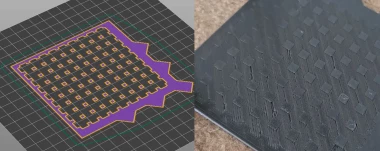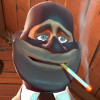Designing models for 3d printing
I came across a really clever idea today for minimizing warping on a large flat surface. The modeller made the first two layers into a series of bridges, which seems to let the plastic shrink and stretch a bit, also preventing some possible blobbing.
At least I assume that’s what’s going on here. I’ve never seen it before, but it printed great without curling or warping.
I’ve also picked up some looser ideas. Things like:
- Adding a 0.02 tolerance to interlocking part will help parts fit together. Adding small chamfers to edges will also help
- 3 shells helps give a nice, smooth surface
- Orienting parts on the bed so that layers are perpendicular to stress can prevents layers from delaminating in functional parts
- Orienting parts such that fine details are vertical will help things look prettier
- Add slight chamfers on the underside of overhangs can help minimize or even eliminate the need for supports
- Create inset holes with this method to eliminate the need for supports. This also works with other shapes
What other modelling tricks have you seen?


Add comment